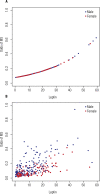Leptin as a predictor of metabolic syndrome in prepubertal children
- PMID: 27598976
- PMCID: PMC10522114
- DOI: 10.1590/2359-3997000000199
Leptin as a predictor of metabolic syndrome in prepubertal children
Abstract
Objective: Leptin has been suggested as a potential biomarker of cardiovascular risk. This paper aims to ascertain, based on a sample of prepubertal children, which serum leptin value best suited to identify metabolic syndrome (MS).
Subjects and methods: This observational, cross-sectional study recruited children from the outpatient pediatrics clinic, with the purpose of validating serum leptin level cutoffs to identify MS. All obese and overweight children who met eligibility criteria were included in the study, as was a sample of normal-weight children. The sample underwent clinical assessment and blood fasting glucose, lipid profile, insulin, and leptin were measured. Sensitivity and specificity were estimated for each leptin measurement, using MS as the outcome. These values were used to construct a receiver operating characteristic (ROC) curve. The association between MS and leptin was assessed using logistic models to predict MS.
Results: A total of 65 normal weight, 46 overweight, and 164 obese children were analyzed (160 boys, 115 girls; age: 93.7 ± 17.8 months). The most appropriate leptin cutoff was 13.4 ng/mL (sensitivity 67.6%; specificity 68.9%; accuracy 72.1%). The logistic model indicated that leptin levels above 13.4 ng/dL were significantly associated with MS and that, for every 1 ng/dL increase in leptin levels, the odds of MS increase by 3% (p = 0.002; OR 1.03; 95% CI 1.01-1.05).
Conclusions: Leptin may be a useful biomarker of cardiovascular risk in prepubertal children, with an optimal cutoff of 13.4 ng/mL. Identification of potential new risk markers for cardiovascular disease in children could contribute to the development of preventive strategies.
Conflict of interest statement
Disclosure: no potential conflict of interest relevant to this article was reported.
Figures


Comment in
-
Metabolic syndrome in children and teenagers: worth assessing it, but how?Arch Endocrinol Metab. 2017 Jan-Feb;61(1):1-4. doi: 10.1590/2359-3997000000249. Arch Endocrinol Metab. 2017. PMID: 28273200 Free PMC article. No abstract available.
Similar articles
-
The relationship between serum adiponectin, tumor necrosis factor-alpha, leptin levels and insulin sensitivity in childhood and adolescent obesity: adiponectin is a marker of metabolic syndrome.J Clin Res Pediatr Endocrinol. 2009;1(5):233-9. doi: 10.4274/jcrpe.v1i5.233. Epub 2009 Aug 4. J Clin Res Pediatr Endocrinol. 2009. PMID: 21274300 Free PMC article.
-
Metabolomics allows the discrimination of the pathophysiological relevance of hyperinsulinism in obese prepubertal children.Int J Obes (Lond). 2017 Oct;41(10):1473-1480. doi: 10.1038/ijo.2017.137. Epub 2017 Jun 7. Int J Obes (Lond). 2017. PMID: 28588306
-
Metabolic syndrome and leptin concentrations in obese children.Indian J Pediatr. 2006 Jul;73(7):593-6. doi: 10.1007/BF02759924. Indian J Pediatr. 2006. PMID: 16877853
-
Use of Continuous Metabolic Syndrome Score in Overweight and Obese Children.Indian J Pediatr. 2019 Oct;86(10):909-914. doi: 10.1007/s12098-019-02994-5. Epub 2019 Jul 13. Indian J Pediatr. 2019. PMID: 31300954
-
Leptin-adiponectin imbalance as a marker of metabolic syndrome among Chinese children and adolescents: The BCAMS study.PLoS One. 2017 Oct 11;12(10):e0186222. doi: 10.1371/journal.pone.0186222. eCollection 2017. PLoS One. 2017. PMID: 29020116 Free PMC article.
Cited by
-
Leptin and Leptin receptor polymorphisms, plasma Leptin levels and obesity in Tunisian volunteers.Int J Exp Pathol. 2018 Jun;99(3):121-130. doi: 10.1111/iep.12271. Epub 2018 Jun 11. Int J Exp Pathol. 2018. PMID: 29893028 Free PMC article.
-
Non-Traditional Cardiovascular Risk Factors in Adolescents with Obesity and Metabolic Syndrome May Predict Future Cardiovascular Disease.Nutrients. 2023 Oct 12;15(20):4342. doi: 10.3390/nu15204342. Nutrients. 2023. PMID: 37892418 Free PMC article.
-
Metabolic determinants of lupus pathogenesis.Immunol Rev. 2020 May;295(1):167-186. doi: 10.1111/imr.12847. Epub 2020 Mar 12. Immunol Rev. 2020. PMID: 32162304 Free PMC article. Review.
-
Useful Biomarkers of Metabolic Syndrome.Int J Environ Res Public Health. 2022 Nov 15;19(22):15003. doi: 10.3390/ijerph192215003. Int J Environ Res Public Health. 2022. PMID: 36429722 Free PMC article.
-
Biomarkers Predictive of Metabolic Syndrome and Cardiovascular Disease in Childhood Cancer Survivors.J Pers Med. 2022 May 27;12(6):880. doi: 10.3390/jpm12060880. J Pers Med. 2022. PMID: 35743665 Free PMC article. Review.
References
-
- Flores LS, Gaya AR, Petersen RDS, Gaya A. Trends of underweight, overweight, and obesity in Brazilian children and adolescents. J Pediatr (Rio J). 2013;89:456-61. - PubMed
-
- Steinberger J, Daniels SR. Obesity, insulin resistance, diabetes and cardiovascular risk in children. Circulation. 2003;107:1448-53. - PubMed
-
- Gimeno RE, Klaman LD. Adipose tissue as an active endocrine organ: recent advances. Curr Opin Pharmacol. 2005;5:122-8. - PubMed
-
- Malincikova J, Stejskal D, Hrebicek J. Serun leptin and leptin receptors in healthy pubertal children: relations to insulin resistance and lipid parameters, body mass index, tumor necrosis factor alpha, heart fatty acid binding protein, and IgG anticardiolipin. Acta Univ Palacki Olomuc Fac Med. 2000;143:51-7. - PubMed
Publication types
MeSH terms
Substances
LinkOut - more resources
Full Text Sources
Other Literature Sources
Medical
Miscellaneous
